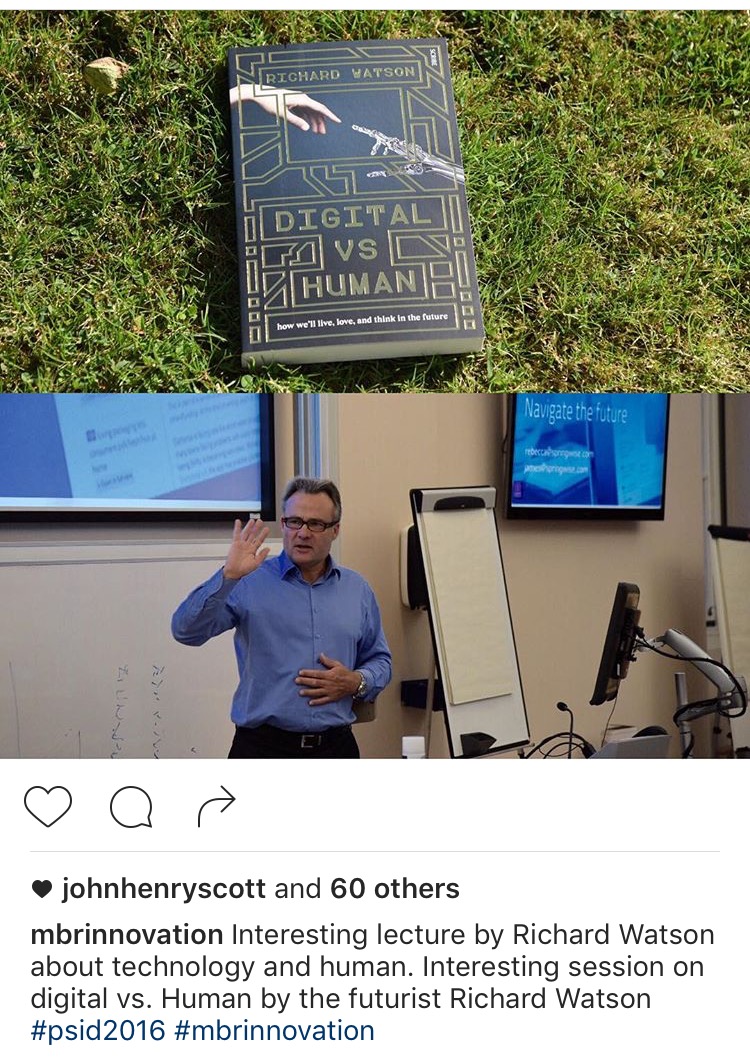Talk for the Dubai government at Judge Business School at Cambridge University recently. https://www.instagram.com/mbrinnovation/?hl=en
Category Archives: Uncategorized
Dystopic Thought for the Day (is that even a word?)
“Let’s imagine… if you glimpsed the future, you were frightened by what you saw, what would you do with that information? You would go to… the politicians, captains of industry? And how would you convince them? Data? Facts? Good luck!
The only facts they won’t challenge are the ones that keep the wheels greased and the dollars rolling in. But what if… what if there was a way of skipping the middle man and putting the critical news directly into everyone’s head? The probability of wide-spread annihilation kept going up. The only way to stop it was to show it. To scare people straight. Because, what reasonable human being wouldn’t be galvanized by the potential destruction of everything they’ve ever known or loved?
To save civilization, I would show its collapse. But, how do you think this vision was received? How do you think people responded to the prospect of imminent doom? They gobbled it up like a chocolate eclair! They didn’t fear their demise, they re-packaged it. It could be enjoyed as video-games, as TV shows, books, movies, the entire world wholeheartedly embraced the apocalypse and sprinted towards it with gleeful abandon. Meanwhile, your Earth was crumbling all around you. You’ve got simultaneous epidemics of obesity and starvation. Explain that one!
Bees and butterflies start to disappear, the glaciers melt, algae blooms. All around you the coal mine canaries are dropping dead and you won’t take the hint! In every moment there’s the possibility of a better future, but you people won’t believe it. And because you won’t believe it you won’t do what is necessary to make it a reality. So, you dwell on this terrible future. You resign yourselves to it for one reason, because that future does not ask anything of you today.
So yes, we saw the iceberg and warned the Titanic. But you all just steered for it anyway, full steam ahead. Why? Because you want to sink! You gave up!”
From Tomorrowland
Reasons to be Cheerful

Who are we? Why are we here and where are we going? If anxiety about climate change, financial meltdowns, terrorism, immigration, pandemics, and the robot that recently went rogue on Twitter isn’t enough to worry about, we’ve got existential questions to contend with. Mostly we haven’t though, largely because a daily deluge of digital distractions means we rarely get much further than worrying about why BBC Three is now only available online or whether answering an instant message during sex is less rude than not responding until tomorrow.
The best bit of advice for such complex conundrums probably comes from The Hitchhiker’s Guide to the Galaxy by Douglas Adams. The advice is simply: “Don’t Panic!” This is wise counsel; especially if instead of looking forwards, you look backwards over a few thousand years and notice that the human race is more or less still here. We’re survived ice ages, financial collapses, religiously inspired terrorism, immigration, pandemics and the threat of new technology before. We’ve even endured Paris Hilton, Ed Miliband and Paul Daniels, at least one of which turned out to be all right really.
None of this means we should become complacent. As the great economist JK Galbraith once said” There will be no harm in making mild preparations for our destiny.” Furthermore, while the thought of robots stealing our jobs and perhaps even our children’s souls is a concern, it could be that the pace of developments in computing means that it isn’t the clumsy idiot savant software than we have today that we need to worry about, but what their silicon descendants might be capable of doing in 20 or thirty years time. If human minds as sharp as Stephen Hawking, Bill Gates and Elon Musk believe that true artificial intelligence (broad or general AI) might be the last invention that the human race ever makes, perhaps we should stop looking at Rich Cats of Instagram and pay proper attention to what’s really going on.
I really have no idea how the distant future will pan out, but my best guess is that we’ll more or less be alright, especially if we, the human race, can somehow remain humane and coalesce around a common vision of what our new technology is actually for. Technology is a tool. It is a way. It is a means. It has never been, and never should be, an end it itself. Technology should only be used to enhance or compliment human thinking and relationships, never to replace them. Any wealth that accumulates from the application of such technology should also be gently persuaded to trickle towards those individuals who find themselves on the wrong side of many of these marvels.
I am hopeful that as AI and robotics evolves and starts to behave more like us this will shine an especially strong spotlight on what it is that humans actually are and what they do best. Nobody expects a second renaissance as a result of artificial intelligence, but it would be nice if real human stupidity were diluted and that we congratulated ourselves about the fact that it’s only humans, not machines, that are capable of creating real joy and that imagination, along with empathy, do not appear to be computable.
In the meantime, rejoice in the knowledge that even the smartest robot in the room still struggles to make a decent cup of tea and is totally bewildered by why humans might want their tea, along with their pizza, delivered by drone when they appear to be pondering the nature of their own existence through a poem by Shelly. Illogical.
Google’s revenge
Loving this!
I hate Easyjet
Do you know what I hate about easyjet? Everything. Late. Very late. As is often the case.
Attack of the drones
Another one from Matt…while I get my act together with the next What’s Next.
Unmanned Aerial Vehicles or UAVs are not a new invention. In 1849, Austria attacked Venice using unmanned balloons filled with bombs. Since then, UAVs — or “drones” as they are commonly known — have been used in several wars as decoys and reconnaissance aircraft. In recent years, they have also been armed with laser-guided missiles and bombs and used — somewhat controversially — by the US to attack targets in Afghanistan and Pakistan.
Drones are also taking off in the hobbyist sector, typically in the form of quadcopters. These work with two sets of counter-rotating blades, which makes them inherently more stable, easier to control, and cheaper to produce than radio-controlled helicopters or planes. Many can be controlled using a smartphone or tablet, and most come equipped with a camera for taking photos and video. They’re cheap, too — you can pick up tiny ones for as little as $15 on Amazon.
As well as flying for fun, quadcopters are being used in an ever-growing variety of ways, including surveillance, filmmaking, journalism, law enforcement, scientific research, and archaeology. Delivery drones are a hot area: they’ve already been used to deliver medicines, and many companies are looking into using drones for commercial goods delivery, from Amazon’s “Prime Air” service to the TacoCopter, delivering — you guessed it — tacos to smartphone-equipped hipsters in the SF Bay Area.
However, there are still obstacles to overcome, mainly to do with regulation and safety. This year, a rather disturbing video of a quadcopter appearing to fire a handgun appeared on YouTube. There are also many privacy issues to think about. Most countries have fairly tight regulation around UAVs, and it’s not yet legal to use them commercially in the US (which is the main reason we haven’t seen Amazon Prime Air yet). However, this regulation is likely to become more flexible over time. In a few years from now, drones might be as commonplace as buses on your local high street.
Refs:
https://en.wikipedia.org/wiki/Unmanned_aerial_vehicle
http://www.bbc.com/news/world-south-asia-10713898
https://en.wikipedia.org/wiki/Quadcopter
http://www.bhphotovideo.com/explora/video/features/are-quadcopters-legal%3F
https://en.wikipedia.org/wiki/Amazon_Prime_Air
http://tacocopter.com
https://thestack.com/world/2015/07/16/a-drone-firing-a-gun-so-this-is-what-all-the- regulation-is-about-2/
No idea!
Solipsism in pop music
Interesting, perhaps, that Love Yourself by Justin Bieber has been number 1 in the UK music charts and has been 1 or 2 for the last 10 weeks. Does this tell us anything? (cue endless Bieber jokes I’m sure…).
From Harvard Business Review Daily Stat. Link to research above here.
Thought for the day
I’m reading The End of Absence: Reclaiming What We’ve Lost in a World of Constant Connection by Michael Harris and something he says really resonates. He says that: “every second of your lived experience represents new connections among the roughly eighty-six billion neurons packed inside your brain.” But he also says that the “three pound lump of gray jelly” that is our brain hasn’t changed much in 40,000 years. I think what he’s getting at is that our brains haven’t changed very much, but that our minds constantly do. And here lies the problem – our software is battling our hardware.
Think of it this way. Your brain is a 1982 Sinclair ZX Spectrum computer with a 16 KB memory, but your mind is constantly trying to install the latest software, Microsoft Word 2016, for instance, onto the device.







